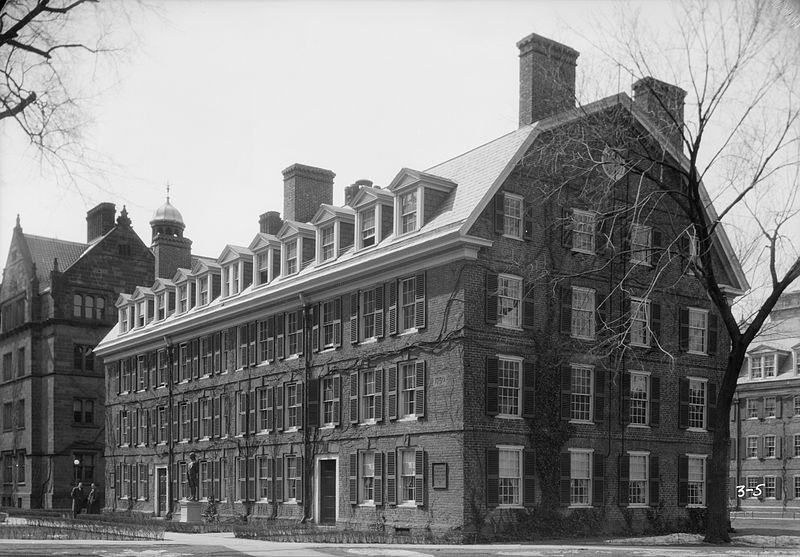Connecticut Hall
Introduction
Text-to-speech Audio
Built between 1750 and 1752, Connecticut Hall is Yale's oldest surviving building, designed along the same lines as the 1720 Massachusetts Hall building at Harvard. It was originally a dormitory, and was later converted to contain meeting and office space. In 1925, McClellan Hall was constructed across from Connecticut Hall as its architectural twin.
Images
Connecticut Hall, photographed by Joseph C. Berlepsch in 1934 (source: Library of Congress)

Backstory and Context
Text-to-speech Audio
Connecticut Hall
Designed by Francis Letort and Thomas Bills, Connecticut Hall is an example of Georgian architecture. The building, named after the Colony of Connecticut, was described as "the best building in the colony" (quoted in "National Register"). It stands 3 stories tall and features a gambrel roof and 124 windows. It is made of red brick, with brown sandstone caps on the doors and windows.
The Hall has undergone several modifications over the years and narrowly avoided demolition. In the 1790s, John Trumbull criticized its old-fashioned appearance, so the building received a new roof to replace the gambrel original. During the mid-19th century, however, the Hall was still attracting criticism: it was labeled "dilapidated, scabby, and malodorous" (quoted in "National Register"). It was saved through the efforts of a group of alumni, as well as by the renewed popularity of colonial architecture in the 1890s. At that point, Connecticut Hall received another new roof--gambrel, to recreate the style of the original. The building later underwent major interior renovations in the 1950s.
Early history of Yale
Yale was founded in 1701 and is the third oldest institution of higher education in the country (after Harvard and William and Mary). The College moved to New Haven in 1716. It took its named from retired East Indian merchant Elihu Yale, who made substantial donations to the school. Over the course of the 18th century, Yale expanded, constructing Connecticut Hall, and hiring professors in divinity, math, physics, and astronomy. The 19th century saw continued developments: the creation of a School of Medicine, Divinity School, School of Law, and a Graduate School.
Designed by Francis Letort and Thomas Bills, Connecticut Hall is an example of Georgian architecture. The building, named after the Colony of Connecticut, was described as "the best building in the colony" (quoted in "National Register"). It stands 3 stories tall and features a gambrel roof and 124 windows. It is made of red brick, with brown sandstone caps on the doors and windows.
The Hall has undergone several modifications over the years and narrowly avoided demolition. In the 1790s, John Trumbull criticized its old-fashioned appearance, so the building received a new roof to replace the gambrel original. During the mid-19th century, however, the Hall was still attracting criticism: it was labeled "dilapidated, scabby, and malodorous" (quoted in "National Register"). It was saved through the efforts of a group of alumni, as well as by the renewed popularity of colonial architecture in the 1890s. At that point, Connecticut Hall received another new roof--gambrel, to recreate the style of the original. The building later underwent major interior renovations in the 1950s.
Early history of Yale
Yale was founded in 1701 and is the third oldest institution of higher education in the country (after Harvard and William and Mary). The College moved to New Haven in 1716. It took its named from retired East Indian merchant Elihu Yale, who made substantial donations to the school. Over the course of the 18th century, Yale expanded, constructing Connecticut Hall, and hiring professors in divinity, math, physics, and astronomy. The 19th century saw continued developments: the creation of a School of Medicine, Divinity School, School of Law, and a Graduate School.
Sources
"Architecture of Yale." Yale University. Accessed February 22, 2017. http://visitorcenter.yale.edu/architecture.
Brown, Elizabeth. New Haven: A Guide to Architecture and Urban Design. New Haven, CT: Yale University Press, 1976. p. 122.
"National Register of Historic Places Inventory--Nomination Form: Connecticut Hall, Yale University." U.S. Dept. of the Interior, National Park Service. December 06, 1974. Accessed February 22, 2017. https://npgallery.nps.gov/pdfhost/docs/NRHP/Text/66000806.pdf.
Brown, Elizabeth. New Haven: A Guide to Architecture and Urban Design. New Haven, CT: Yale University Press, 1976. p. 122.
"National Register of Historic Places Inventory--Nomination Form: Connecticut Hall, Yale University." U.S. Dept. of the Interior, National Park Service. December 06, 1974. Accessed February 22, 2017. https://npgallery.nps.gov/pdfhost/docs/NRHP/Text/66000806.pdf.
